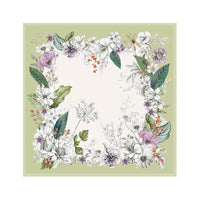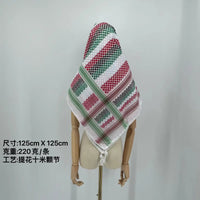During the Qatar World Cup, locals adorned traditional Arab scarves with patterns representing participating countries, often leading to sell-outs even before matches began. For Arabs, the scarf is not just an everyday accessory but a symbol imbued with cultural heritage and national sentiment. The way scarves are worn, their colors, textures, and styles vary significantly across different Arab countries and even within the same nation, reflecting diverse social strata.

The Evolution of Scarf Colors
Over a thousand years ago, Arabs living in desert regions adopted the practice of wrapping their heads, faces, and bodies to protect themselves from the harsh sun, prevent dehydration, and shield themselves from sandstorms. Today, wearing a scarf signifies maturity for men. An elderly Bedouin shared, "When a Bedouin boy turns 15, his father gifts him a scarf. It's the best gift in the world, marking his transition into manhood. Wearing a scarf is an honor."
Initially, scarves came in limited colors like beige, white, and black. However, as civilizations progressed and social classes emerged, scarves became markers of status. Headbands and scarves varied greatly between commoners and aristocrats. Common headbands were made of wool or camel hair, while those of the aristocracy often incorporated gold or silver threads, and royal headbands were wrapped in layers of silk, exuding nobility. Similarly, the quality of scarves differed; commoners wore cotton or silk scarves reaching their shoulders, while aristocrats sported silk scarves draping past their shoulders, with princes' scarves extending almost to their ankles, exuding an air of grandeur. In terms of color, commoners were restricted to plain tones like white or black, while aristocrats could don blue scarves. The combination of red, yellow, and blue, reserved exclusively for royalty, symbolized rarity and prestige due to the scarcity of such pigments in medieval times.
The Story Behind Saudi Red and White Scarves
Each Arab country has its unique scarf culture. Emiratis, for instance, typically wear white scarves adorned with black headbands, a simple yet popular style in the Arab world due to its ease and casual flair. In Qatar, the scarf-tying method is more intricate, with men folding their scarves into a cobra-like shape and stiffening the fabric for better draping.
Saudi scarves, renowned for their complexity and fashion-forward appeal, often feature red and white checks. This pattern dates back to World War I, when the British exported large quantities of red and white scarves to support Arab rebels in the Ottoman Empire, with red representing the British flag and white revered by Arabs. Thus, the red and white check became a symbol of alliance with Britain.
Distinctive Omani Scarf-Wrapping Traditions
Kuwaitis value symmetry in their scarf-tying, creating a balanced and orderly appearance. Bahrainis, on the other hand, adopt a butterfly-like tying method, offering freedom of movement to the head and neck.
Among all Arab nations, Omanis exhibit the most distinctive scarf-wrapping traditions, reflecting their vibrant personalities and passion for life. Their scarves, resembling small round caps (known as masar caps), are tightly wrapped around the head, compact yet dynamic. Individuals add personal touches, such as wider edges, twisted corners, or pointed foreheads, creating a variety of sleek and unique styles. Omani scarves come in a rainbow of colors, with patterns ranging from simple stripes to intricate floral designs, embodying their aesthetic sensibilities and love for beauty.
A Symbol of Diversity and Unity
These scarves, though small, carry profound cultural, value, and lifestyle implications, as highlighted by Morgan Freeman during the Qatar World Cup opening ceremony, representing "the unique story of this land." The cultural depth and evolution encapsulated within these scarves invite us to discover, study, and appreciate their beauty, fostering tolerance and respect for diversity.





